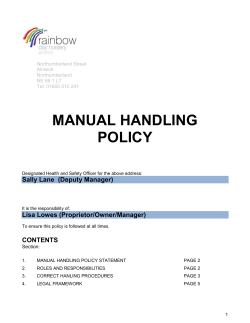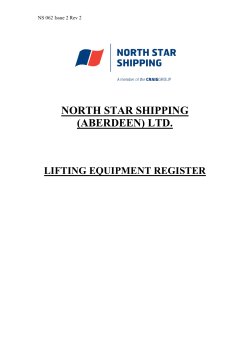
Rigging and Slings
073: Rigging and Slings Facilitator duties for this session: Obtain a sling to demonstrate making a hitch during the discussion portion. What this Safety Talk covers: Rigging dangers and precautions. Importance Each year, too many people who over-simplify or underestimate the value of proper rigging lose fingers, toes, hands, feet and, in some cases, their lives. Inadequate rigging also damages loads and anything in their path. All lifting, rigging and slinging gear and equipment must be inspected by a competent person for its safe working load limit, wear and damage and adequacy for the type of lift it is to be used for and its intended purpose. Hitches You use a sling to make a hitch, which is what holds the load to the rest of the rigging. The three basic kinds of hitches are basket, choker, and vertical. Reference Material: The basket hitch requires an extra hook. It cradles, rather than pinches, the load. For further information refer to: Use the choker to lift cylindrical items that need extra sling adhesion and can take the force generated by their own weight. An example is a conduit bundle. Relevant State Legislation Company Policy Statement Company Work Method Statement Slings Employee Guide to Safety Slings come in a wide range of lifting capacities, weaves, and materials. If a load has a lifting hook, you can use a vertical hitch to lift it. Before using a sling, inspect the sling body and the seam of each eye. If a sling shows wear, replace it. The four basic types of slings are the straight eye, reverse eye, endless, and metal triangle. The straight eye is also called eye and eye, and is general purpose. Avoid using it for the vertical hitch. The reverse eye is general-purpose. Because the eyes are reversed, you should use this sling for making the choker hitch. Avoid using it for the vertical hitch. Think of a no eye sling. That’s what the endless sling is. It can provide more strength than an eyed sling, and using it is trickier. A metal triangle, or plate hardware sling helps extend the life of a sling. A sling may use a metal triangle on one end only, in which case it works well in a choker hitch used with lifting hook. A sling may use a metal triangle on each end, making it ideal for a basket hitch but worthless as a choke hitch. Slings vs. Loads To determine if a given sling can lift the intended load, calculate the maximum lifting angle the sling will experience in the intended lift. Use the chart that came with the sling to see its lifting capacity for each angle. Review and Discussion Why is the subject of rigging and slings important? What are the three basic hitches and how do you apply them? The lifting capacity also applies when you use a sling to hold a load in place. Remember, the lifting capacity decreases as the included angle increases. Lines Avoid using fibre rope on pulls that aren’t straight. Pad all sharp corners. If using a wire rope, ensure the ends are correctly seized. In what ways can slings differ? What is a straight-eye sling? What is its general applicability, and where should you avoid using it? The lift What is a reverse-eye sling? What is its general applicability, and where should you avoid using it? Keep your hand as far from pinch points as you can to reduce the possibility a frayed wire will catch your glove and jerk your hand into a pinch point. How do you use a sling that has no eyes, and what is it called? Anticipate some load movement and position yourself accordingly. How do you determine if a given sling can lift the intended load? What does lifting capacity do as the included angle increases? Where should you avoid using a fibre rope? Where should you position your hands and body in relation to the load when the lift is underway? If possible, release the sling or choker from your grasp before giving the “all clear” signal. You may be able to make this possible by using a board or other prop. If you must touch any part of the rigging, keep your hand clear of pinch points. You can’t always position the hook exactly over the load centre, and loads can shift. Never place yourself between the load and an object that can trap you in the path of the load’s swing. Never stand under the load. Competency Most loads to be lifted by cranes and other lifting equipment are required to be slung by a Dogman or Rigger being the holder of a current Certificate of Competency as required by State and federal legislation. If you are not the holder of these certificates leave the crane and slinging work to the trained and competent people to do. Notes: __________________________________________________________________________ __________________________________________________________________________ __________________________________________________________________________ __________________________________________________________________________ __________________________________________________________________________ __________________________________________________________________________ __________________________________________________________________________ __________________________________________________________________________ __________________________________________________________________________ __________________________________________________________________________ __________________________________________________________________________ __________________________________________________________________________ © 2005 National Electrical and Communications Association. All rights reserved 073: Rigging and Slings Review and Assessment Participant Name:_____________________________________________ Please circle the correct answer to the following questions. Inadequate use of rigging and slings does no damage to loads and anything in their path. True False All lifting, rigging and slinging gear and equipment must be inspected by a competent person for its safe working load limit, wear and damage. True False The three basic kinds of hitches are basket, choker, and vertical. True False Before using a sling, inspect the sling body and the seam of each eye. If the sling shows wear, replace it. True False To determine if a given sling can lift the intended load, calculate the maximum lifting angle the sling will experience in the intended lift. True False Remember, the lifting capacity of the sling increases as the included sling angle increases. True False Always use fibre rope on cable pulls that aren’t straight. True False Never place yourself between the load and an object that can trap you in the path of the load’s swing. True False Most loads to be lifted by cranes and other lifting equipment are required to be slung by a Dogman or Rigger being the holder of a current Certificate of Competency. True False Keep your hand as far from pinch points as you can to reduce the possibility a frayed wire will catch your glove and jerk your hand into a pinch point. True False Participants Signature:__________________________ Date:__________ © 2005 National Electrical and Communications Association. All rights reserved Toolbox Talks Register 1. TOOLBOX TALK NUMBER / DETAILS 073: Rigging and Slings Date: _________________ Session Leader / Trainer Name: ______________________________________________ Time Commenced: __________________ Time Completed: _______________________ Site / Project Location: _____________________________________________________ 2. PARTICIPANTS PRESENT Name 3. Signature ISSUES ARISING FROM TALK Session Leaders Sign Off: ______________________________________
© Copyright 2025









